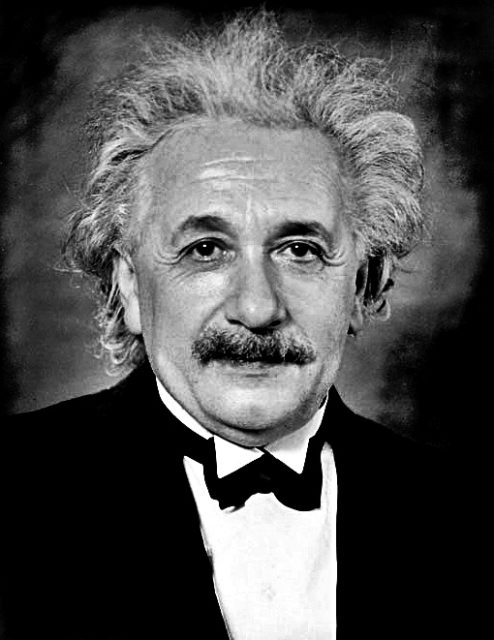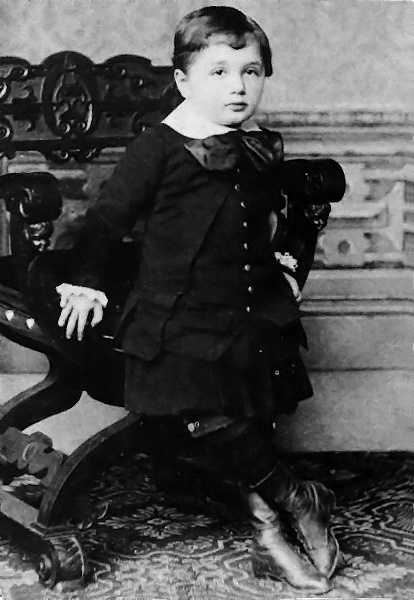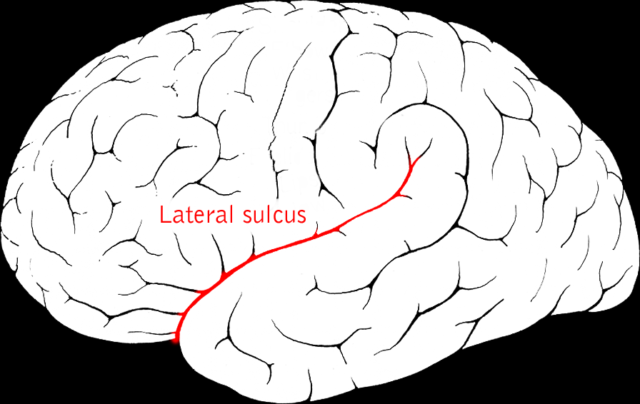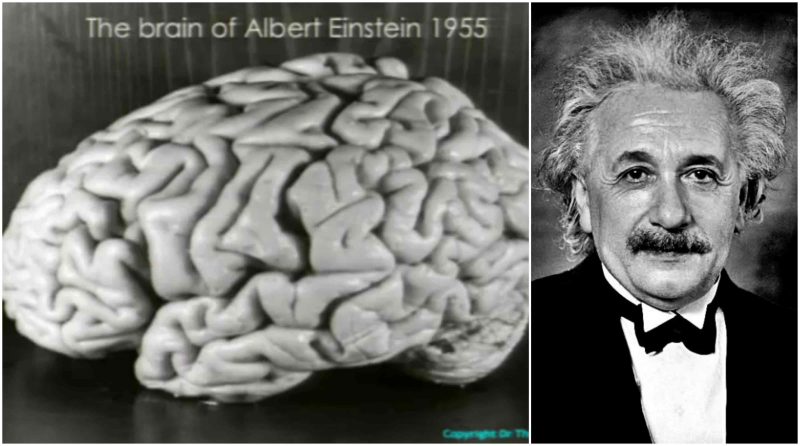Did you know that Einstein’s brain was removed within seven and a half hours of his death? Well, it was but this fact was not revealed until 1978. The brain of physicist Albert Einstein has been a subject of much research and speculation.
The brain has attracted attention because of Einstein’s reputation as one of the foremost geniuses of the 20th century, and apparent regularities or irregularities in the brain have been used to support various ideas about correlations in neuroanatomy with general or mathematical intelligence.
Scientific studies have suggested that regions involved in speech and language are smaller, while regions involved with numerical and spatial processing are larger. Other studies have suggested an increased number of glial cells in Einstein’s brain.
Einstein’s autopsy was conducted in a lab at Princeton Hospital by pathologist Thomas Stoltz Harvey shortly after his death in 1955. Harvey removed and weighed the brain at 1,500 grams (more than the average adult, at 1,400). Then, took it to a lab at the University of Pennsylvania where he dissected Einstein’s brain into several pieces; some of the pieces he kept to himself while others were given to leading pathologists. He claimed he hoped that cytoarchitectonics would reveal useful information.
Harvey injected 50% formalin through the internal carotid arteries and afterwards suspended the intact brain in 10% formalin. Harvey photographed the brain from many angles. He then dissected it into about 240 blocks (each about 1 cm3) and encased the segments in a plastic-like material called collodion.Harvey also removed Einstein’s eyes, and gave them to Henry Abrams, Einstein’s ophthalmologist.
Whether or not Einstein’s brain was preserved with his prior consent is a matter of dispute. Ronald Clark’s 1979 biography of Einstein states, “he had insisted that his brain should be used for research and that he be cremated”, but more recent research has suggested that this may not be true, and that the brain was removed and preserved without the permission of either Einstein or his close relatives. Hans Albert Einstein, the physicist’s elder son, endorsed the removal after the event, but insisted that his father’s brain should be used only for research to be published in scientific journals of high standing.
In 1978, Einstein’s brain was “rediscovered” in Dr. Harvey’s possession by journalist Steven Levy. The brain sections had been preserved in alcohol in two large mason jars within a cider box for over 20 years. A minor media sensation ensued, with reporters camping out for days on Dr. Harvey’s lawn.

Harvey went to California, and paid a visit to Evelyn Einstein, Einstein’s granddaughter. At the time, she was divorced and struggling financially. The fact that Harvey kept her grandfather’s brain struck her as creepy but she was interested in one secret it might hold. She was the adopted daughter of Hans Albert and his wife Frieda. She heard rumors that she might actually be Einstein’s own daughter.
Einstein had relationships with various women and she thought that she could have been a result of one of those relationships and that Einstein had arranged it with Hans Albert to adopt her. Unfortunately, the way Harvey embalmed the brain made it impossible to extract usable DNA, so her curiosities were never satisfied.
In 2010, Harvey’s heirs transferred all of his holdings constituting the remains of Einstein’s brain to the National Museum of Health and Medicine, including 14 photographs of the whole brain (which is now in fragments) never before revealed to the public.
More recently, 46 small portions of Einstein’s brain were acquired by the Mütter Museum in Philadelphia. In 2013, these thin slices, mounted on microscope slides, went on exhibit in the museum’s permanent galleries.
Harvey had reported that Einstein had no parietal operculum in either hemisphere, but this finding has been disputed. Photographs of the brain show an enlarged Sylvian fissure. In 1999, further analysis by a team at McMaster University in Hamilton, Ontario revealed that his parietal operculum region in the inferior frontal gyrus in the frontal lobe of the brain was vacant.
Also absent was part of a bordering region called the lateral sulcus (Sylvian fissure). Researchers at McMaster University speculated that the vacancy may have enabled neurons in this part of his brain to communicate better. “This unusual brain anatomy…[missing part of the Sylvian fissure]… may explain why Einstein thought the way he did,” said Professor Sandra Witelson who led the research published in The Lancet. This study was based on photographs of the whole brain made at autopsy in 1955 by Harvey, and not direct examination of the brain.
Einstein himself claimed that he thought visually rather than verbally. Professor Laurie Hall of Cambridge University, commenting on the study, said, “To say there is a definite link is one bridge too far, at the moment. So far, the case isn’t proven. But magnetic resonance and other new technologies are allowing us to start to probe those very questions.
In the 1980s, University of California, Berkeley professor Marian C. Diamond persuaded Thomas Harvey to give her samples of Einstein’s brain. She compared the ratio of glial cells in Einstein’s brain with that of the preserved brains of 11 other people. (Glial cells provide support and nutrition in the brain, form myelin, and participate in signal transmission, and are the other integral component of the brain, beside the neurons.)
Dr. Diamond’s laboratory made thin sections of Einstein’s brain, each 6 micrometers thick. They then used a microscope to count the cells. Einstein’s brain had more glial cells relative to neurons in all areas studied, but only in the left inferior parietal area was the difference statistically significant.
This area is part of the association cortex, regions of the brain responsible for incorporating and synthesizing information from multiple other brain regions. A stimulating environment can increase the proportion of glial cells and the high ratio could possibly result from Einstein’s life studying stimulating scientific problems.

The limitation that Diamond admits in her study is that she had only one Einstein to compare with 11 brains of normal-intelligence individuals. S. S. Kantha of the Osaka Bioscience Institute criticized Diamond’s study, as did Terence Hines of Pace University.
Other issues related to Diamond’s study point out glial cells continue dividing as a person ages and although Einstein’s brain was 76, it was compared to brains that averaged 64 in age. Additionally, there is little or no information regarding the samples of brains that Einstein’s brain was compared against such as IQ score, neurological diseases or other relevant factors. Diamond also admitted that research disproving the study was omitted.His brain is now at the Mütter Museum in Philadelphia and two of the 140 sections are on loan at the British Museum.
Scientists are currently interested in the possibility that physical differences in brain structure could determine different abilities.One part of the operculum called Broca’s area plays an important role in speech production. To compensate, the inferior parietal lobe was 15 percent wider than normal.The inferior parietal region is responsible for mathematical thought, visuospatial cognition, and imagery of movement.

A study published in the journal Brain in September 2013 analyzed Einstein’s corpus callosum – a large bundle of fibers that connects the two cerebral hemispheres and facilitates interhemispheric communication in the brain – using a novel technique that allowed for a higher resolution measurement of the fiber thickness.
Einstein’s corpus callosum was compared to two sample groups: 15 brains of elderly people and 52 brains from people aged 26. Einstein was 26 in 1905, his Annus Mirabilis (Miracle Year). The findings show that Einstein had more extensive connections between certain parts of his cerebral hemispheres compared to both younger and older control group brains.
A study, “The cerebral cortex of Albert Einstein: a description and preliminary analysis of unpublished photographs”,[was published on November 16, 2012, in the journal Brain. Dean Falk, an evolutionary anthropologist at Florida State University, led the study – which analysed 14 recently discovered photographs – and described the brain: “Although the overall size and asymmetrical shape of Einstein’s brain were normal, the prefrontal, somatosensory, primary motor, parietal, temporal and occipital cortices were extraordinary.
“There was a fourth ridge (apart from the three normal people have) in Einstein’s mid-frontal lobe involved in making plans and working memory. The parietal lobes were markedly asymmetrical and a feature in Einstein’s primary motor cortex may have been associated with his musical ability.
Another study led by Shanghai-based East China Normal University’s Department of Physics, “The Corpus Callosum of Albert Einstein’s Brain: Another Clue to His High Intelligence”, published in the journal Brain On September 24, 2013, showed a new technique to conduct the study, which is the first to detail Einstein’s corpus callosum, the brain’s largest bundle of fibers that connects the two cerebral hemispheres and facilitates interhemispheric communication.
Einstein’s corpus callosum was thicker than those in control groups, possibly indicating better cooperation between the hemispheres. Scientists currently cannot tell how far the unusual features above were innate or how far they were due to Einstein devoting his life to higher thought.
